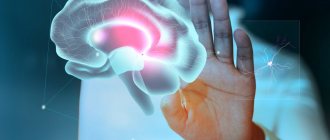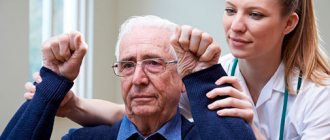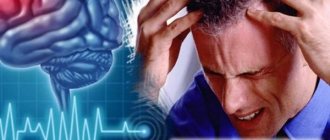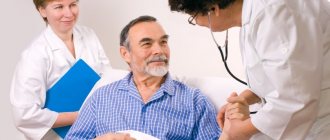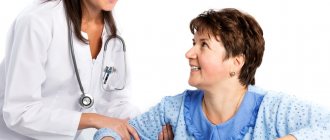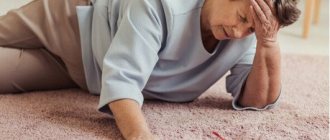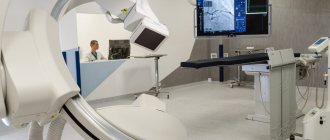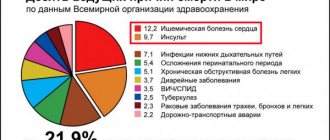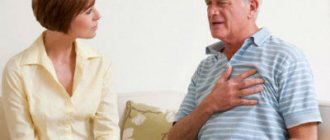A stroke, formerly called apoplexy or cerebral stroke, is an acute disorder of cerebral circulation. Blood does not enter the brain cells, they stop receiving oxygen and begin to die.
During a stroke, a person's abilities that are controlled by the affected area of the brain, including, for example, memory and muscle control, are lost.
A stroke can happen to anyone, anywhere, at any time, which is why it is important to be educated about the signs of a stroke and know what to do.
Causes of stroke
A stroke can be caused by several reasons. The most important risk factors for this condition are smoking, a sedentary lifestyle, alcohol abuse, obesity, and genetic predisposition (cases of strokes in close relatives can be considered an indirect sign). The cause may vary depending on the type of stroke. The two most common types are described below:
A hemorrhagic stroke occurs due to internal bleeding when a blood vessel inside the brain ruptures. Other names for hemorrhagic stroke are cerebral hemorrhage or intracranial hemorrhage. Among the causes of hemorrhagic stroke are:
- inactive lifestyle;
- increased stress levels;
- alcohol abuse;
- obesity;
- smoking.
Hemorrhagic stroke can also be caused by abnormal formation of blood vessels or rupture of dilated vessels (a complication of cerebral venous insufficiency).
Ischemic stroke occurs due to circulatory problems. A typical case is a blood clot blocking the lumen of a vessel. The cause of ischemic stroke can be:
- diabetes;
- excessive alcohol consumption;
- obesity;
- high cholesterol (causing cerebral atherosclerosis);
- smoking;
- arterial hypertension.
Atrial fibrillation, a type of irregular heartbeat, is another cause of ischemic stroke.
Small stroke (micro-stroke). Precursors of a brain catastrophe
Of course, the consequences of a major stroke are the most tragic. But a micro-stroke is no joke. Ignoring this condition is extremely dangerous. Why? Quickly, but not without a trace Strictly speaking, the word “ micro-stroke ” is not from scientific terminology. Doctors in such cases talk about transient cerebrovascular accidents or transient ischemic attacks. They occur due to spasm of cerebral vessels or the formation of blood clots (which leads to temporary and incomplete blockage of blood vessels).
The symptoms of a small stroke are similar to the symptoms of a large one - dizziness, difficulty speaking, numbness and weakness in the limbs (patients often complain that they have rested their arm or lost their leg). The only difference is that all these phenomena are short-lived (from several minutes to several hours) and pass at first glance without a trace.
However, in recent years, thanks to the widespread introduction of neuroimaging methods (CT, MRI), it has been proven that even short-term vascular disorders lead to changes in the substance of the brain. Therefore, the treatment tactics for a microstroke should be the same as for a stroke.
Signs of a small stroke (ministroke):
- Sudden loss of sensation, numbness of any part of the body.
- Loss of coordination, difficulty walking.
- Speech difficulties.
- Memory loss.
- Increased sensitivity to bright lights and sounds.
- Unreasonable severe headache.
Window of hope The therapeutic window (the time when a microstroke can be eliminated without consequences) is no more than 4.5 hours. The most reliable option is to contact a vascular center (they are open in many cities of Russia), which specialize in the treatment of strokes.
Upon admission to the hospital, the patient should undergo an MRI of the brain, ultrasound of the cerebral vessels (feeding the brain), blood and heart tests, which give a complete picture of the risk of developing a major stroke. According to statistics, 60% of patients who have experienced a mini-stroke develop a full-fledged ischemic or hemorrhagic stroke after some time. The next stage is treatment aimed at restoring normal blood supply to the brain. After this, you need to deal with the problems that led to the development of a mini-stroke.
Heat, stress and nerves There are many reasons leading to stroke. The most significant is hot weather. During the smoky summer of 2010, a record number of strokes was recorded in the Central region. In the heat, dehydration occurs, the blood thickens and the likelihood of blood clots increases. The “battle for the harvest” can also end with a blow - people doing intense physical labor under the scorching sun are at risk of getting it.
The most dangerous thing is to stay in a bent position with your head down for a long time. This increases the load on the cardiovascular system and provokes vascular rupture (especially if the patient has an aneurysm - a protrusion of the artery wall). Acute circulatory disorders can be provoked by alcohol abuse, smoking, stress, physical or psychological fatigue, and stress.
Is it written in your family? There are people who live under the sword of Damocles of stroke constantly. These are patients with diabetes, hypertension and angina. They must be under constant medical supervision and regularly take prescribed medications.
Stroke is a natural risk for people with tortuous carotid arteries and cerebral atherosclerosis. Pathology can be detected by duplex scanning of cerebral vessels (the study can be done at any regional clinic). If vasoconstriction is diagnosed, the patient is referred for stenting of the carotid arteries, which restores the lumen in the vessels. Deputy Director of the Scientific Center of Neurology, Doctor of Medical Sciences, Professor Marine Tanashyan spoke about this.
READ in the source...
AiF Health No. 32 08/08/2017
Symptoms of a stroke
The first signs of a stroke are:
- violation of speech coherence. It is difficult to understand what the person is saying;
- the appearance of facial asymmetry. Facial expressions are disturbed; as a rule, one side suffers. If you ask a person in this state to smile, the smile will come out crooked;
- severe weakness of the limbs. As a rule, the limbs on one side are affected (right arm and right leg or left arm and left leg). If a person is asked to raise both arms at the same time, one of them will lag noticeably or will not be able to move at all;
- blurred vision. In this case, one pupil will be dilated more than the second, and chaotic movement of the eyeballs is possible. The patient may feel tightness in the eyes and complain of double vision.
How can you tell when someone is having a stroke?
As a mnemonic rule, you can associate the signs of a stroke with the word IMPACT:
"U" - smile
“D” – hand movement
“A” – articulation
“R” - “solution”: if these signs are undeniable, you need to call an ambulance.
Other manifestations of a stroke may include:
- confusion of consciousness. A person who has suffered from a stroke does not understand well what is being said to him;
- dizziness;
- Strong headache
Ischemic stroke
Treatment of the consequences of ischemic stroke can be divided into several areas:
- Restoration of movement (sessions with a physical therapist, aquatherapy, exercises on simulators, use of modern techniques: Bobath therapy, Exarta, PNF method);
- Returning independence in everyday life (sessions with an ergotherapist in a specially equipped training apartment);
- Restoration of speech and swallowing;
- Drawing up a menu with the recommendations of the attending physician;
- Blood pressure control and drug therapy;
- Hygiene procedures (including ostomy care and ostomy removal);
- Symptomatic treatment (prevention or treatment of bedsores, pain relief, etc.);
- Restoring control of the pelvic organs;
- Treatment of depression, help from a psychologist.
The rehabilitation program is carried out in three stages.
The first stage begins in the first days after an ischemic stroke. The possibilities for active rehabilitation are limited, since the patient is in bed and inactive. The patient is turned over, massaged, and breathing exercises are performed.
It is important to communicate with the patient, even if his own speech is impaired or he cannot respond. Speech perception affects the functioning of functional areas of the brain and has a positive effect on the emotional and physiological state of a person.
The second stage lasts up to several months after the stroke. It can take place either directly in a hospital or in a specialized rehabilitation center. During this period, massage, therapeutic exercises, and physiotherapy are prescribed. Specialists work on speech and cognitive functions (memory, thinking, imagination). This stage can last up to six months: it all depends on the severity of the stroke.
In the late, third, rehabilitation period, active methods are used to restore functions and skills. Fine motor skills and self-care skills are restored. It is also important to develop the patient’s commitment to rehabilitation measures and a positive attitude.
In some cases, one or two courses of rehabilitation are sufficient (the patient is discharged with detailed recommendations and a set of exercises to be performed at home).
deals with treatment after ischemic cerebral stroke. Each specialist conducts an individual examination of the patient and sets time-bound and achievable goals. Team members interact and exchange information to ensure that rehabilitation is effective.
Stroke suffered on the legs: symptoms
This is an insidious disease; many people mistake it for chronic fatigue, bad mood, or sudden changes in weather. However, it is important to notice the signs in a timely manner in order to quickly diagnose the disease and receive medical help.
When to suspect a “silent stroke”:
- headache in the back of the head;
- dizziness;
- slight numbness in the arms, legs, or face;
- a sharp jump in blood pressure;
- sensation of goosebumps;
- decreased skin sensitivity;
- it is difficult to tolerate bright light and loud sounds;
- drooping eyelids;
- failure of motor coordination;
- slight facial asymmetry.
Treatment and rehabilitation after stroke
Therapeutic physical education (PT)
The most important method of restoring motor functions. It is prescribed as soon as the patient’s condition allows him to make feasible movements. The main goal is full or partial restoration of motor function of the body, strength and dexterity in the limbs, and coordination of movements.
In the early period, the patient engages in passive gymnastics together with a physical therapy specialist. Exercises help normalize the tone of the limbs and eliminate the risk of bedsores.
The next stage is active gymnastics. The patient first learns to get out of bed, maintain balance, then walk with support, and then independently. An important component is the restoration of fine motor skills, which is necessary for the patient’s social adaptation. Specialists help to relearn eating, personal hygiene skills, dressing independently, etc.
Massotherapy
Along with exercise therapy, it is an integral part of the rehabilitation program for the return of physical activity. Massage helps relieve pain, eliminates muscle spasms, preserves joint function, and prevents the formation of bedsores at the initial stage, when the patient moves little. In addition, massage prevents pulmonary complications. It also improves blood circulation and normalizes the general condition of the body. Massage is carried out throughout the entire rehabilitation period.
Speech rehabilitation
Speech impairment occurs in more than a third of people who have had a stroke. Moreover, this dysfunction may include not only the loss of the ability to pronounce words independently, but also impaired understanding of the speech of others, forgetting the names of objects and actions. In addition, the articulation of sounds is often impaired, and reading and writing skills are lost. To combat these disorders, long-term classes are required to restore speech functions, which are conducted by a speech therapist-aphasiologist.
It is necessary to start classes already in the initial period, when the level of consciousness allows. Then the exercises become more complicated and the duration of the sessions increases. It is also important for the patient’s family and friends to get involved here. For rehabilitation, not only professional exercises are important, but also constant speech contact at the everyday level.
Drug therapy
It is impossible to achieve stable results without medications. With the help of medications, doctors relieve pain and improve blood circulation, which is necessary to restore the functions of the affected areas of the brain. Medicines also help eliminate the risk of complications. Therapy is carried out only as prescribed by the attending physician. After discharge from the medical center, be sure to take medications!
Psychological therapy
A psychotherapist constantly works with patients during rehabilitation. It helps to cope with depressive emotions, eliminate obsessive thoughts and believe in yourself.
Diet
As a result of a stroke, the blood supply to the brain and blood vessels are affected. Therefore, it is extremely important to reduce your intake of foods containing cholesterol. It is recommended to exclude fatty fried foods and fatty meats from the diet, and reduce salt intake to a minimum. The basis of nutrition should be foods high in fiber and complex carbohydrates. These are vegetables, fruits, cereals. You need to eat foods with polyunsaturated fatty acids: fish, seafood. Low-fat dairy products, boiled or stewed lean meat, bran bread, etc. are also suitable.
In the initial stages of treatment, when it is still difficult for a person to chew, it is necessary to give him only boiled food, preferably pureed. If you are undergoing inpatient therapy, specialists will develop a special diet for the patient and ensure that only the right foods are consumed.
